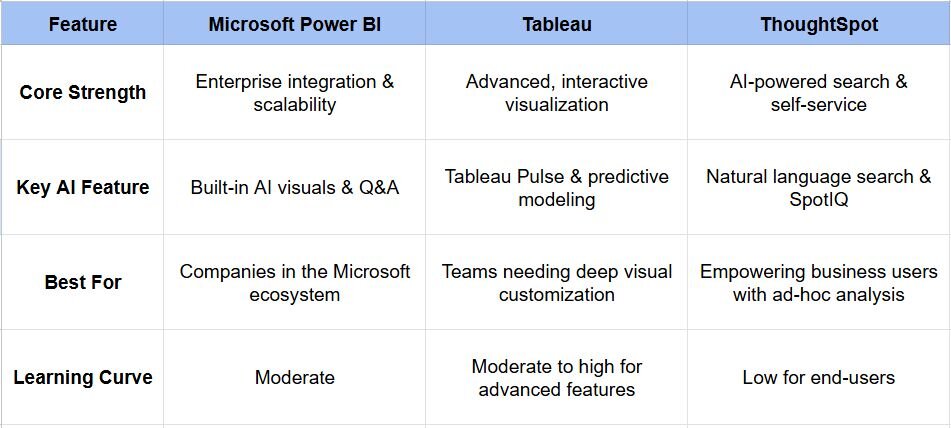August 7th, 2025
Top AI-Powered Metabase Alternatives for Smarter BI
By Laura Clugston · 4 min read

Metabase has earned its popularity as a user-friendly, open-source business intelligence (BI) tool that empowers teams to ask questions and learn from their data. However, as data volumes increase and the demand for more sophisticated insights grows, many organizations find themselves hitting the limits of what Metabase can offer. The platform can struggle with scalability and real-time insights as data complexity increases [1].
This has led to a search for more powerful Metabase alternatives, particularly those enhanced with artificial intelligence. The modern BI landscape is rapidly evolving, with a strong emphasis on AI-assisted workflows, enterprise-grade governance, and seamless collaboration [2].
If you're looking for a smarter BI solution—whether it's a robust Tableau alternative, a scalable Power BI replacement, or even a ChatGPT-like experience for data analysis—this guide will walk you through the top contenders.
Enterprise-Grade Metabase Competitors
For large organizations or those with complex data needs, stepping up to an enterprise-grade platform is often the necessary next move. These tools offer superior scalability, advanced analytics, and deep integration capabilities.
Microsoft Power BI: The Enterprise Powerhouse
Microsoft Power BI stands as a leader in the enterprise BI space, significantly surpassing Metabase in data visualization, scalability, and especially AI-powered insights [1]. It's designed to handle large datasets and integrates seamlessly into the broader Microsoft ecosystem, including Azure, Excel, and Dynamics 365, making it a natural choice for companies already invested in Microsoft products [1].
• Natural Language Q&A: Ask questions about your data in plain English and get visualizations as answers.
• AI Visuals: Access features like automated anomaly detection and predictive analytics directly within your dashboards.
• Azure Machine Learning Integration: Incorporate advanced ML models from Azure for deeper predictive power [3].
Tableau: The Visualization Leader
Tableau is renowned for its best-in-class data visualization capabilities. Its modern, drag-and-drop interface allows for the creation of highly customized and interactive dashboards [4]. While Power BI excels in Microsoft integration, Tableau is often favored for its superior flexibility in visual storytelling and its ability to connect to a vast array of data sources.
• Tableau Pulse: Delivers AI-driven insights directly to users in natural language, helping them stay on top of key metrics [4].
• Predictive Analytics: Use built-in functions for forecasting and trend analysis.
• R and Python Integration: Allows data scientists to embed sophisticated statistical models and scripts directly into Tableau workflows [3].
ThoughtSpot: The Search & AI-Driven Analytics Platform
ThoughtSpot positions itself as a leading alternative to traditional BI tools by focusing on an AI-powered search experience [5]. It empowers non-technical users to perform complex data analysis by simply asking questions in natural language, much like using a search engine. This self-service approach dramatically reduces the reliance on data experts for routine report creation.
• Search-Based Analytics: Its core feature allows users to query data conversationally.
• SpotIQ: An AI engine that automatically uncovers hidden insights, anomalies, and trends in your data without being asked.
• Self-Service Focus: Designed from the ground up to enable anyone in an organization to find their own data-driven answers.
Comparison of Top Enterprise BI Tools

Powerful Open-Source and Developer-First Alternatives
For teams that value customization, control, and a code-first approach, several powerful alternatives offer a different path away from Metabase.
Apache Superset (and Preset)
As a free, open-source platform, Apache Superset is a natural step up from Metabase for enterprises with experienced data teams [6]. It supports large datasets, offers extensive permissioning, and provides a vast library of visualizations.
For teams wanting to avoid infrastructure management, Preset offers a fully hosted and managed service built on Apache Superset, removing much of the operational complexity [1].
Sisense: The Embeddable Analytics Specialist
Sisense excels in its ability to handle large, disparate datasets and embed analytics directly into other applications and workflows [7]. Its AI-driven features are designed to surface insights quickly and can combine data from multiple sources into a single, unified view. This makes it a strong choice for companies looking to provide white-labeled analytics to their own customers [5].
The Rise of Conversational AI in Business Intelligence
A new wave of BI tools is emerging that moves beyond traditional dashboards and reports, focusing instead on a conversational interface. These platforms aim to make data analysis as simple as having a conversation.
This is where Julius AI carves out its unique space. Julius is an AI-powered data analysis platform that allows anyone to get expert-level insights from their data using plain English. Users can upload files (like spreadsheets or CSVs), connect data sources, and then simply ask the AI to analyze, visualize, and model the information.
Julius is particularly useful for knowledge workers who may not have a dedicated data analyst on their team or for data scientists looking to automate tedious and manual tasks. Instead of learning a complex interface like Power BI or Tableau, you can input commands or ask questions like:
• "Show me the month-over-month sales growth for the last year as a bar chart."
• "Clean this dataset by removing duplicate rows and filling in any missing values in the 'revenue' column."
• "What is the correlation between marketing spend and customer acquisition?"
By democratizing data analysis through a simple, conversational AI, Julius acts as a powerful alternative for teams who find Metabase too limiting but don't need the enterprise-scale complexity of a tool like Tableau. It bridges the gap, making sophisticated data analysis accessible to everyone.
How to Choose the Right AI-Powered BI Tool
Selecting the best Metabase alternative depends entirely on your organization's unique needs. Ask yourself these questions:
• Who are the users? Are they data scientists who need Python integration, or business users who need a simple point-and-click or conversational interface?
• What is your existing tech stack? If your company runs on Microsoft, Power BI offers strong integration [1].
• What is your primary goal? Do you need to embed analytics in a product (Sisense), create interactive dashboards (Tableau), or enable fast, conversational analysis (Julius)?
• What is your budget and scale? Open-source tools like Superset offer a free starting point, while enterprise platforms come with significant licensing costs [6].
Frequently Asked Questions (FAQs)
What is the best free AI-powered alternative to Metabase?
For simple BI needs and strong integration with Google products, Google's Looker Studio (formerly Data Studio) is a widely used free tool [6]. For more control and customization, the open-source Apache Superset is a powerful choice, though it requires technical expertise to set up and maintain.
Is Power BI better than Metabase?
"Better" is subjective. Power BI is more powerful, scalable, and has more advanced AI features than Metabase [1]. However, Metabase is valued for its simplicity and open-source nature, making it faster to deploy for basic analytics. For complex enterprise needs, Power BI is generally the superior choice.
Can AI replace data analysts?
No, AI is helping data analysts, not replacing them. AI-powered BI tools automate time-consuming tasks like data cleaning, report generation, and surfacing initial insights. This frees up analysts to focus on more strategic work, such as interpreting the "why" behind the data, communicating findings to stakeholders, and driving business strategy. Well-designed dashboards and AI tools can enhance decision-making speed, empowering analysts to be more effective [3].
